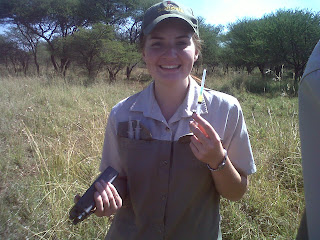This morning, while Lisette and me were doing spot checks and started to clean the owls cage, this means raking up all the feathers, taking out the bowl that was left there from the previous days feeding, with the 1st years, we found a dead chicken under one of the trees. Most of the chicken was eaten up but the feathers were all still lying there. We think that this may be Savanna (female serval) that escaped a few days ago from her cage with Bacardi(Male serval).
Savanna wasn’t hand raised when we got her so she still had her natural instinct to hunt for herself. Because she has been in the wild life centre for so long she knows that there is food here. If she was hungry this would be the first place that she would return to. The chickens were easy food to catch because Paulina (worker that cleans around the Wild Life Centre) usually puts the chickens back into their enclosure in the evenings to protect them from being caught during the night. Except this night Paulina wasn’t there to place them back into their cage and the rest of us forgot about them.
When the chickens sleep they are at their most vulnerable and it was easy prey for Savanna to catch. Because they are mostly nocturnal animals this was the time she would be searching food.
We have an enclosure where the Kudus (Dandy- female and Houdini- male) and Zena-female Oryx Gazelle, sleep and stay during the day. This enclosure has a bonnox fence that is too small for them to fit through so that they might escape, but what happened was, when we were still bringing them in during the night so that they could be warmer inside because they were still small babies, it was quite hard to catch Houdini and Dandy because they weren’t used to being caught and it is their natural instinct to run when someone is chasing them, so we would be a few people that tried to get him into a corner so that there would be no way for him to go. The result of this was that sometimes they would jump into the fence itself to get away from the people moving closer to him as he would see it as the only escape route. They don’t notice the fence because it doesn’t have any covering like netting over it so that they can see the fence so when their stressing they would try and go right through it.
This resulted in the fence wire being bent or the holes in the bonnox being made a lot bigger, or the wire even breaking. There was a lot or loose wires sticking out through the fence that could hurt the animals in the enclosure itself, or the animals passing the enclosure that are free roaming in the wild life centre or even the people and guests passing the enclosure can get stuck on the wires. Me and Gunter bent over the loose pieces of wire to make it safer for the meantime. We tried to move the wire back to the place that it was to make the holes the same size as it was but the wire was damaged too much. Once the one hole was back to its original size, another hole would be bigger than it should be.
We called Daniel (worker) to come fix the wire properly with adding other pieces of wire and by using the proper equipment.








































